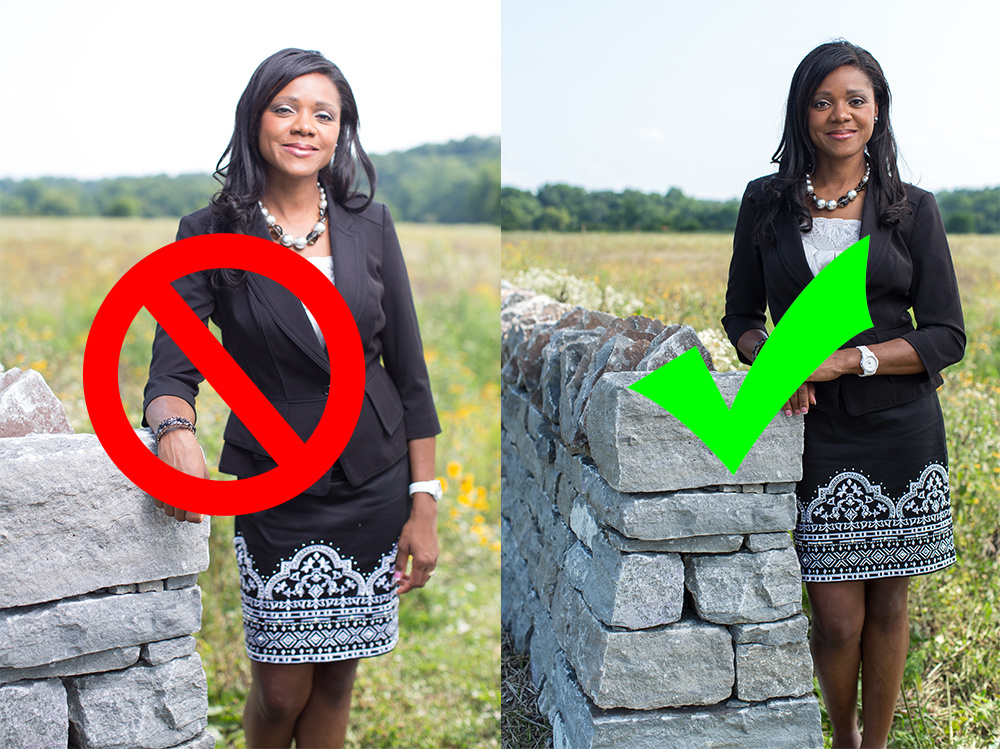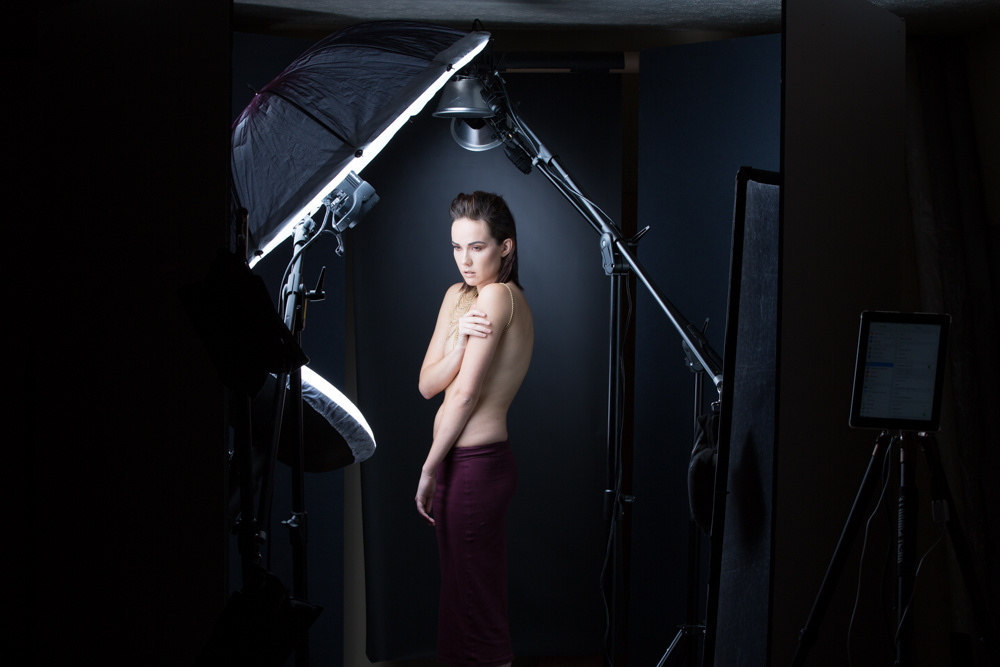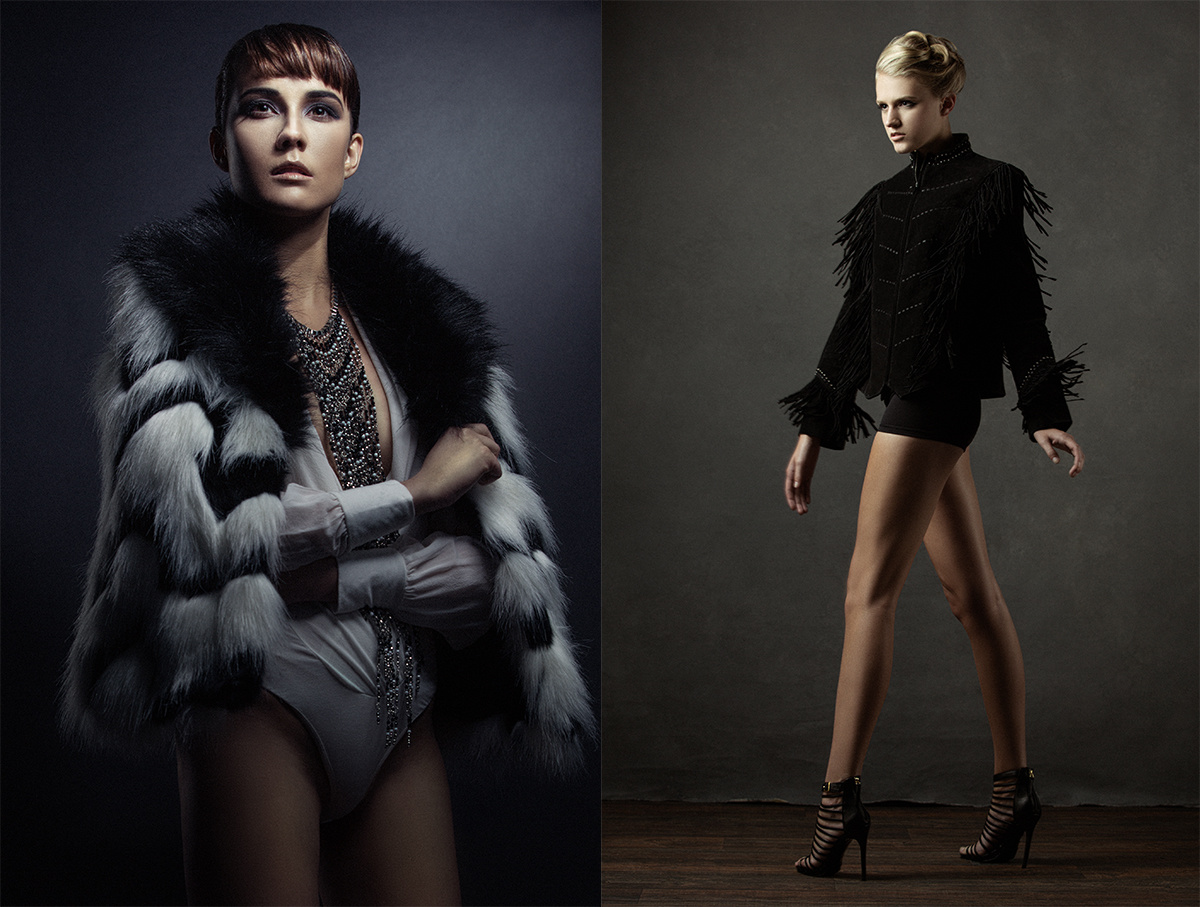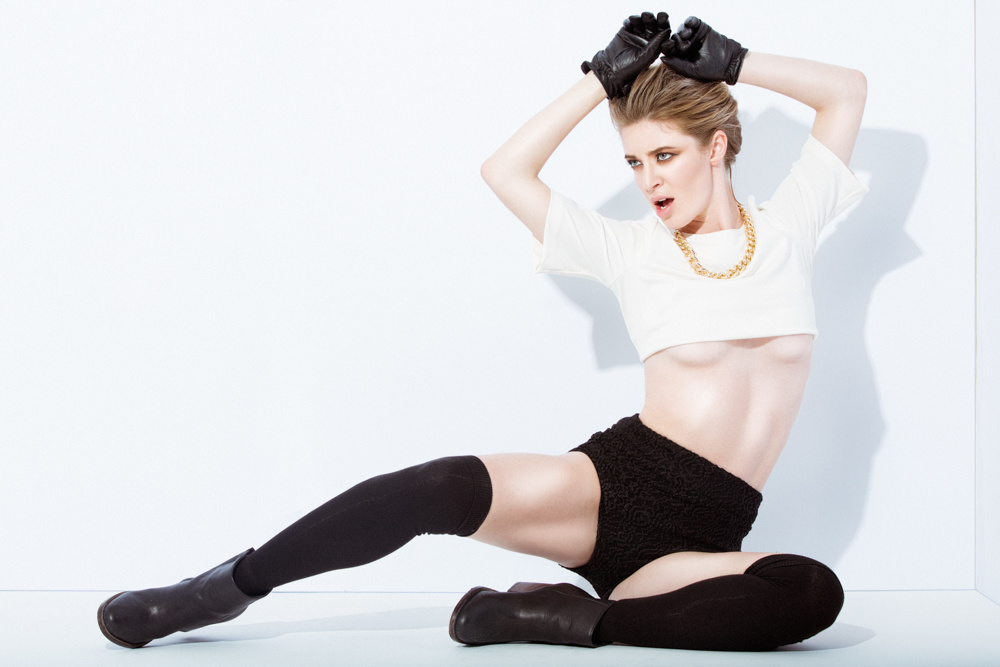We’ve all been there, stuck with bad light and fresh out of ideas. I may spend up to an hour pre-lighting before a model or subject steps onto set, I work out the kinks and make sure everything is how it should be. But, despite my best efforts to make it right, every now and then I run out of time and have to wing it. We all have our “go to” lighting scenarios, but when you’re standing in unknown territory, keep the following tips in mind and you just might make it through the storm.
Too Much, Or Not Enough Ambiance
When shooting on location, I love blending and mixing ambient light with artificial light. It can add drama and a mood that natural light just cannot produce. But, sometimes adding too much ambience with artificial light can take away from the image and have a negative impact. On the same token, a shot with not enough ambience and a barrage of flash can look cheap and overdone. Check out my article “Up the Ambient, Create Beautiful Portraits by Mimicking Daylight” where I cover this exact dilemma. Shutter speed controls ambient light and does not affect artificial light, which provides the opportunity to increase the exposure of natural light to balance both the flash and ambiance. It simply depends on the mood and feeling you want your image to express, but remember ambience light is a powerful tool and should never be ignored with a standard 1/200 shutter speed.
Right Face, Wrong Modification
There is beauty in every face, whether your subject is round, slim, soft or hard there is a right modifier for every sort of face. And with that said, there is a wrong modifier for every sort of face. I can’t tell you how many times I’ve setup a light scenario and pre-lit for hours only to find that the modifier I landed on wasn’t right for the person I was shooting. It sends everyone into a frenzy to find the right light, but with experience you know what’s right and what is wrong. As a general rule, I've found that hard light only works for people with strong jaw lines and slim faces. Soft light really plays well to people with more round faces. In example, I probably wouldn’t use a silver beauty dish for a headshot portrait of a lawyer, unless it was an editorial look I was going for. So, find what works for your style and be sure to analyze who you’re shooting before they step in front of your lens and under your lights.
More Boom
I always loved the look of a boomed overhead light, it’s empowering and dramatiic. When I first started photography, I knew I needed a boom stand, but I couldn’t afford anything nice. And, I was certainly not going to boom out an expensive light on an inexpensive stand. So, I tried different methods such as clamping a light to a background stand or hanging a light from the ceiling. The attempts were successful, but completely impractical. When I finally decided to invest in a boom stand, it really changed everything for me. I was able to put my lights in positions and places that is simply impossible with a regular light stand. If you’ve ever seen behind the scenes stills from big productions, lighting grips usually have some sort of soft light source from directly above which imitates natural overhead light. When all else fails put a soft light overhead and work forward from there.
Too Far And Away
During my normal daily cruise through Facebook, I come across tons of behind the scenes images in which I see photographers place their soft modified light source 10-15 feet away from the subject and parallel to themselves, resulting in a nice flat light. The closer the light source is to the subject the softer the light will fall on the face. Don't be afraid to place that light close to your subjects face and body. On many occasions, I have had the light less than a foot from the cheek and if you were to look at my RAW images, the modifier can be clearly seen in the frame. But, with a quick cloning session in Photoshop any and all distractions can be removed. If you’re going for a harder light, then stick that light even further, 15-20 feet back from the subject! But, if your objective is soft light, get that light close, 1-2 feet close. If you're weary of having the light in the shot, invest in a boom stand.
Overlighting
We’re all guilty of this. Just this past week, I had the bright idea to experiment with a 6-light beauty setup and really step into unfamiliar ground with fill from a beauty dish. Was it overkill? Yes. Was it good? Eh. Lighting is a game of light and shadows, drama is caused by shadows not light. That is exactly what I failed to realize. If you’re stuck in a light setup, then stop, backtrack and start reducing the amount of light by taking away strobes, you’ll see an increase in shadows and perhaps the dramatic image you’re seeking. If you still need a stroke of inspiration to get back into the game, check out my article “Beyond The Key - Building A Subtle Light Setup,” which provides some insight into how I build subtle light scenarios.
Don’t Forget A Fill
You just never know, everything might be where it should be and the only thing you might be forgetting is a simple chest-level fill from a reflector. It can provide an amazing pop and some beautiful catchlights. By setting a softly modified light source or a piece of white foam core next to those strong shadows, you can reduce the contrast and provide more playing room in post processing. Many photographers use fill under the chest for beauty or fill opposite of the key light for less shadow density. Although this isn't a pivotal point of light, it can definitely help out when you need it most. A fill light should not be forgotten while working with light.
Sometimes, it all just doesn’t work. But keep trying, keep working at it and take it one step at a time. Perhaps, a simple tip of the face or turn of the subject’s body can completely change the game, so don’t get discouraged when the first shot isn’t what you expect.
At the end of the day, if you have solid subject matter, a happy client and good result then the light was right.



















Great article and photos Clay, as always!
Thank you Ernst! Really appreciate that!
very informative as are all your articles!
Thank you for reading Simon!
Great article. Lots of useful info. Thanks!
Thanks for checking it out Brian! Cheers!
Another great post Clay!
Just out of curiosity what are you using for flooring on the first image beneath "Don’t Forget A Fill"?
Thanks!!
Thank you James! That is sheet vinyl I picked up at a local flooring installer. Ask for any vinyl REM's and they'll point you in the right direction.
That's exactly what I thought!
Thanks!!!
Thanks mate! Great write up, I've been in that boat plenty of times with my light.
Appreciate that Kyle! Cheers my friend!
Great work! Lots of information and well illustrated! Love to see also the light scenarios.
Beuautiful results ( pics ) at the end of the day!
Thanks Hugo! Really appreciate you reading the article! Cheers!
Wonderful article. Thanks for sharing!
Thanks Willis! Thanks for reading! :)
Best quote, "Was it good? Eh." At least I don't feel so bad now when my seemingly great idea fails to turn out as planned. Great article...thanks for posting.
Thanks Jason! That "Eh" seems to come out of my mouth quite often. All part of the pre-lighting stage I suppose!
That was pretty good. Made me chuckle.
Heck yea, man! This is a great article for those starting to experiment with more than one light. I got called the day before last about doing a shoot for a baseball player when I've never really worked with hard lighting and more than one or two strobes at a time. After reading, it started to click more of things I should be looking for to save myself the headache in from of a paying client. It's not always the simplest to figure out when your on set, but knowing what to look for will definitely keep me less stressed when walking through whats wrong in my head.
Thanks David! That is awesome to hear. Good luck on the shoot, share the results, I'd love to see what you do!
I had a friend call me to shoot some senior portraits for someone who needed them in a hurry and when we talked on the phone, I was under the impression that she wanted to have some sport shots done since her son was a football/baseball player. I prepared for that but then last minute, walked in with khakis, polos and one baseball jersey shirt.
I had to switch it up real fast and knowing what could work against me was a big help. I ended up using a Alienbee 800 with a PCB 36" octobox as my key light with an Alienbee 400 on the white seamless. I used a PCB stripbox on the jersey shot with a sb900 kicking on the back.
I feel like this could have been executed better if I used a smaller softbox (24" range) but I didn't have one at my disposal.
Edit - The first two have been retouched while the last one has just had some minor Lightroom adjustments.
Love how you say step back because sometimes people don't think of that. they just keep adding and adding hoping for a different result. I have run into that myself and have since said less is better typically. Build from 1 and see how it goes. Great article, thanks for sharing
Thanks for reading Jeff. Totally, less is more!
Thank you for this great article! Really helpful
Really appreciate that Martin!
Lots of great tips and advice in the article Clay! Having a boom and a short backlight stand are some of those things that really level you up in your lighting skills.
Totally! Thanks for reading Ed!
Thanks Clay, I always find useful advice in your posts. Thanks for sharing!
That's awesome, glad to hear it! Thanks for reading!
Great stuff as usual Clay, love your pics too :)
Appreciate that Bob! Cheers!
Wow, Thanks Clay, Awesome article, so much details, information, tips and tricks, reminders of do's and dont's. This is a serious piece of work, Thanks a million for it. (a good kick in the butt for improvement and playing, trial and error in the studio this is for me).
Thank you for reading Olivier! Really appreciative of the feedback and comment.
Great Article Clay!
Thanks Shawn!
Great article Clay! Found you through a post you made in Strobist. Definitely a fan now.
Awesome Michael! Thanks for checking it out man!
Quite simply one of the best articles I have read in a long time, balancing theory and practical applications along with photos that back up the points you are making. Congrats Clay, thank you.
Bruce, thank you for the awesome feedback! Really appreciate the kind words. Cheers!
BAM!!!
BAAM! as Linus would say. :) really good tips to write down.
Thank you Karl!
Great article, Clay! Very helpful and informative. I'm mostly a scenic and wildlife photographer that's slowly transitioning into people and portraiture. I've been following your articles and personal growth for months now. Your willingness to share information, exemplified here, is invaluable. Thank you! Keep up the amazing work!
Thank you Craig, that means a lot. I still have a lot to learn, but its guys like you that keep me pushing harder. Cheers my friend.
Good article Clay, however I do feel that you've kinda misled people with the image of the photographer with his light 10-15ft away and shooting that group portrait. While I understand what you are saying and I completely agree with you about moving your light in close, the image you have "X'ed" out was a group portrait, and in that situation I would assume the photographer is trying to get even light across all the subjects, so in order to do that it is necessary for him pull it back some distance (inverse square law). If it was an individual and he was pulling it back that far, that would make your point better, but for the group image if he pushes it close he's going to have one subject lit right and the others falling off into shadow. Anyways, still love all your points.
Thanks Jason! I appreciate you reading and the valuable feedback. Perhaps, that was not the best example to share of the "Too Far and Away" section. But, it's the only image I could find in my infancy as a photographer where I did that. I didn't want to throw any other photographers under the bus.
I don't shoot groups often, so I didn't have another example of the proper way to do things, but If I needed more light, I would simply bring in a bigger light source rather then pulling the light back. The further the light is from the subject, the harder the light will become. I'll definitely work on making the example clearer next time!
Thanks again man!
You could've thrown me under the bus. I definitely did that with individuals in my infancy with photography as well. In fact I used to do it and with a beauty dish 10-15 feet away no less. ;)
Ha! We've all been there my friend!
Too far and away is the absolute biggest reason people end up fearing flash (and thus begin calling themselves a natural light photographer as if it's purely by choice). They put their flash on , get some distance away and go WOAH, thats harsh. Backup further, then it's inneffective or impossible to get enough power out of. People really need to start by powering it down and getting it as close as possible!
Totally Robert! Thanks for sharing that!